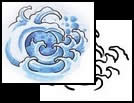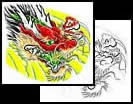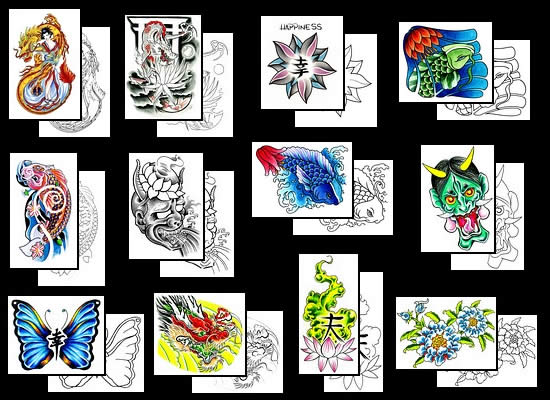TATTOO DESIGNS & SYMBOLS - JAPANESE TATTOOS
Tattoo Symbol Index - ABCDEFGHIJKLMNOPQRSTUVWXYZ
Tattoo designs - J >> Japanese
 Japanese Tattoo Designs - From fierce dragons to delicate flower blossoms or large intricate scenes of samurai warriors locked in mortal combat with powerful demons, Japanese style tattoos can provide designs and symbols that work for anyone. Whether it's akoi lazily swimming across a hip, an emerald serpent slithering up a calf, a ring of cherry blossoms joined together in an ankle or armband, or a samurai and lady embracing on your back, you may find yourself enticed into wearing them all as part of your personal Japanese tattoo. An integral part of the beauty and allure of traditional Japanese tattooing is the capacity for the forms and designs to evolve and develop over time from smaller, separate individual tattoos into magnificent motifs that may encompass an arm as a sleeve or become an entire back-piece or eventually morph into an all encompassing kimono that may cover the entire body!
Japanese Tattoo Designs - From fierce dragons to delicate flower blossoms or large intricate scenes of samurai warriors locked in mortal combat with powerful demons, Japanese style tattoos can provide designs and symbols that work for anyone. Whether it's akoi lazily swimming across a hip, an emerald serpent slithering up a calf, a ring of cherry blossoms joined together in an ankle or armband, or a samurai and lady embracing on your back, you may find yourself enticed into wearing them all as part of your personal Japanese tattoo. An integral part of the beauty and allure of traditional Japanese tattooing is the capacity for the forms and designs to evolve and develop over time from smaller, separate individual tattoos into magnificent motifs that may encompass an arm as a sleeve or become an entire back-piece or eventually morph into an all encompassing kimono that may cover the entire body!
Tattoo design in Japan was greatly influenced by the woodblock prints (ukiyoe) found in novels and colourful advertisements for plays, particularly during the late18th and into the 19th century. The literary heroes depicted in the woodblock designs were often shown with extensive and elaborate tattoos. Some of these were so spectacular -- particularly those by the woodblock artist Kuniyoshi -- that the youth of the day were inspired to have the images tattooed on their own bodies. |
 Classical tattooing conformed to specific designs for those legendary heroes and religious symbols, artistically and harmoniously combined with animal and floral motifs. These were set against a backdrop of elemental symbols such as clouds, bolts of lightning and waves. The designs were often drawn onto the tattoo client by the woodblock artist himself and then inked by the tattooist. These images covered the back and continued on to the arms, legs and chest. Commonly, the only areas not tattooed were the hands and feet, from the wrist and ankle down, and the head, from the neck up.
Classical tattooing conformed to specific designs for those legendary heroes and religious symbols, artistically and harmoniously combined with animal and floral motifs. These were set against a backdrop of elemental symbols such as clouds, bolts of lightning and waves. The designs were often drawn onto the tattoo client by the woodblock artist himself and then inked by the tattooist. These images covered the back and continued on to the arms, legs and chest. Commonly, the only areas not tattooed were the hands and feet, from the wrist and ankle down, and the head, from the neck up.
The artist, Hokusai, broke away from the traditional motifs and introduced highly stylized land and seascapes, the most famous being the instantly recognizable, 'Beneath the Wave'. He also introduced a shade of blue not previously found in Japan, having acquired it from his friend and fellow painter, Manet, one of the French Impressionists. The full-body suit, which is synonymous with Japanese tattooing, made its appearance during that period.
The first evidence of Japanese tattoo design can be seen on 5000-year-old figurines recovered from tombs. They displayed etched and painted faces, mostly simple marks and lines, believed to indicate social rank and protection from evil spirits. In the 3rd century AD, Chinese historical texts speak of Japanese men and boys decorating their faces and bodies with tattoos. There is also mention of Japanese fishermen painting their bodies to protect themselves from large fish when they dove for shells.
Centuries later, in large part due to the powerful cultural influence of China, tattooing in Japan became taboo, a mark largely reserved for the outcast and criminal. Those wearing tattoos were ostracized, essentially doomed to live outside the domain of family and society. Of course, the indigenous Ainu people enjoyed a different aesthetic code. Living on Hokkaido, the most northern of the Japanese islands, they considered their young girls beautiful for receiving decorative tattoos on their lips, legs, arms and hands. Although no longer practiced today, elderly Ainu woman still showed the tattoos they received as young girls up until the 1980's.
Towards the end of the 17th century, penal tattooing was replaced by other forms of punishment, and decorative tattooing began to emerge. It became popular among the criminal classes, who transformed their 'marks of the criminal' into something more beautiful. It was also popular with firefighters, who were drawn to employ many water symbols as amulets of protection in their dangerous work. The relationship between machismo attitude and aesthetic sensibilities was thereby established. The original punitive markings on criminals, usually in the form of rings around the wrists, or lines down the arm, were called Geishin. The process of covering them over with beautiful tattoos was known as 'sleeving'. It is thought that the historical connection between tattooing and organized crime in Japan began at that time. A little over a century later (around 1827), a famous yakuza (Japanese mafia), named Seibei, had the image of a revered Japanese poetess and cherry blossoms tattooed on his waist, hands and legs.
Although tattooing in Japan continued to be outlawed, there was no law against tattooing foreigners. Tattoo masters set up business in Yokohama and were kept busy tattooing foreign sailors. So great were their skills, that foreign kings and emperors traveled to Japan to receive tattoos from the great masters of the day. Unlike the Western tattoo, a traditional Japanese design consisted of a single theme or subject and required a huge commitment of time -- not to mention a certain physical sacrifice to withstand the pain.
The tattooist in Japan was considered a highly skilled craftsman and underwent a rigorous apprenticeship, living with the master for five years. He was called horimono to distinguish him from the carvers of woodblocks, who were called hori, which means 'to carve, scrape or inscribe'. Not the least important skill acquired through apprenticeship was a full understanding of the meanings of the traditional designs. The untrained tattooist might not appreciate the importance of expressing all four seasons on the skin. He might reveal his ignorance by incorporating both snake and cherry blossom in the same scene. At the time a cherry tree blooms, the snake is hibernating underground. Integral to the designs were an elaborate system of symbols, that combined the principles of yin and yang, the use of negative space within the art, an aesthetic appreciation for the lines of the human body and the art of telling a story through the use of specific images that was meant to reveal the character of the individual through the tattoos.
 Within traditional Japanese tattooing, certain design elements are often paired together, the dragon and the phoenix, or lions and demons with various flowers - in effect a delicate balancing of power with beauty. Peonies, for example, or "botan" are a flower symbol that is traditionally paired with a Japanese lion, or "Shishi". This pairing is called Karajishi, and the ferocity of the lion is tempered by the beauty of the peony. But rather than merely being a simple symbolic example of Yin and Yang at work, the peony is a powerful tattoo design element in its own right.
Within traditional Japanese tattooing, certain design elements are often paired together, the dragon and the phoenix, or lions and demons with various flowers - in effect a delicate balancing of power with beauty. Peonies, for example, or "botan" are a flower symbol that is traditionally paired with a Japanese lion, or "Shishi". This pairing is called Karajishi, and the ferocity of the lion is tempered by the beauty of the peony. But rather than merely being a simple symbolic example of Yin and Yang at work, the peony is a powerful tattoo design element in its own right.
Kanji characters are often incorporated into traditional Japanese tattoos, with meanings and expressions that are often times quite specific to the individual being tattooed.
According to the tattoo master, Kazuo Oguri, a good tattoo is not simply a picture. A good tattoo is much more than the sum of its separate parts. The design needs to be bold and clearly visible from a distance of some yards. Too much detail undermines the graphic appeal.
A tattoo master employs the traditional Japanese art of hand-tattooing known as tebori, rather than using an electrical tattoo machine. With tebori, a greater degree of subtlety and tone gradations is achievable. The practice is encouraged in Japan where organizations exist to preserve the tradition.
After WWII, tattooing was no longer illegal, yet it remained concealed from the public eye. Tattoo artists worked privately through appointments.
In today's Japan, displaying one's tattoos in public is still not generally approved of, since many of the under-classes and members of organized crime are heavily tattooed, although these attitudes are rapidly changing among latest generation of young Japanese. Hotels and bars hoping to deter the rowdier clientele may ban those sporting visible tattoos.
Kanji are a wildly popular choice among those seeking Japanese style tattoo designs. Kanji, one of the three scripts that make up the Japanese language, are in fact Chinese characters introduced into Japan around 500 AD. These calligraphy-style characters are ideograms, meaning that each one has its own meaning and translates into words like Happiness, Wealth, Love, Lovers, Laughter, Sadness, Beautiful, Duty, and Loyalty. Expressions are built up by combining the number of kanji used, making it possible to create and display any number of messages. There are thousands of characters and innumerable combinations, so it's important that your tattoo artist knows exactly which meaning or message you wish to convey.
See also: Hannya Masks,Tengu, Oni Mask Tattoos,Japanese Tattoo Index
History of Japanese & Chinese tattooing
Buy one of these Japanese Tattoo design ideas from Tattoo Johnny

Tattoo designs - J >> Japanese
Tattoo Symbol Index - ABCDEFGHIJKLMNOPQRSTUVWXYZ
ConversionConversion EmoticonEmoticon